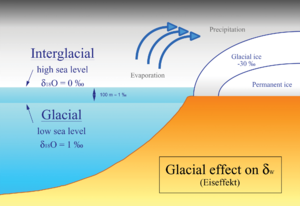Nicholas Shackleton facts for kids
Quick facts for kids
Sir
Nicholas Shackleton
|
|
|---|---|
| Born | 23 June 1937 |
| Died | 24 January 2006 (aged 68) |
| Nationality | British |
| Known for | Quaternary Period |
| Awards | Fellow of the Royal Society Lyell Medal (1987) Wollaston Medal (1996) Urey Medal (2003) Vetlesen Prize (2004) Blue Planet Prize (2005) |
| Scientific career | |
| Fields | Geology |
| Influences | Harry Godwin |
Sir Nicholas John Shackleton (born June 23, 1937 – died January 24, 2006) was an important English scientist. He was a geologist, which means he studied the Earth's rocks and history. He was also a paleoclimatologist, someone who studies Earth's past climates.
Nicholas Shackleton was especially interested in the Quaternary Period. This is the most recent period of Earth's history, covering the last 2.6 million years. It includes the Ice Ages. He was the great-nephew of the famous explorer Ernest Shackleton.
Contents
Studying and Working at Cambridge
Nicholas Shackleton went to Cranbrook School, Kent. After that, he studied natural sciences at Clare College, Cambridge University. He earned his first degree in 1961. Later, in 1967, he received his PhD. His PhD research was about measuring past temperatures during the Quaternary Era.
Shackleton spent almost his entire scientific career at Cambridge University. He worked in the Department of Earth Sciences. He also worked at the Godwin Institute for Quaternary Research. He became a special professor there in 1991.
Understanding Earth's Past Climate
Sir Nicholas Shackleton was a leader in paleoceanography. This field studies the history of the oceans and how they relate to climate. He wrote over 200 scientific papers.
He was one of the first to use special machines called mass spectrometry. These machines helped him study tiny fossils from the ocean floor. By looking at the oxygen inside these fossils, he could figure out how Earth's climate changed over time.
Shackleton also found proof that Earth's magnetic field flipped 780,000 years ago. This means that north became south and south became north!
In 1976, he became very well known for a paper he wrote with James Hays and John Imbrie. It was called "Variations in the Earth's orbit: Pacemaker of the ice ages." They used cores of ocean sediment (mud from the bottom of the ocean). These cores showed that changes in Earth's climate over millions of years matched changes in Earth's orbit around the Sun. This idea is known as Milankovitch cycles.
Later, Shackleton worked on creating very accurate timelines. He matched the regular cycles found in deep-sea sediment cores. These cycles were linked to how much sunlight Earth received at different times. This method helped scientists understand how fast climate changes happen.
In 2000, Shackleton published an important study. It looked at how oxygen in the oceans related to oxygen in ice from Antarctica. This helped explain how much deep ocean temperature and ice volume changed. It also showed how closely carbon dioxide levels and temperature have been linked for the last 400,000 years.
In 1995, Shackleton became the Director of the Godwin Institute. He was knighted in 1998 for his amazing work in Earth sciences. From 1999 to 2003, he was the president of a big international group called the International Union for Quaternary Research (INQUA).
In 2010, Sir Nicholas Shackleton was honored on a set of postage stamps. This was to celebrate the 350th anniversary of the Royal Society. He was chosen to represent Earth Science. There is also a special medal named after him, given for work in climatology.
A Passion for Clarinets
Besides being a brilliant scientist, Shackleton was also a talented amateur clarinet player. He loved collecting woodwind instruments. His home in Cambridge became a famous place for musicians and scholars to visit.
He was known around the world as an "organologist." This means he studied musical instruments. He wrote many articles and contributed to important music dictionaries.
Sir Nicholas Shackleton collected over 700 instruments! Most of his huge collection was given to the University of Edinburgh after he passed away. Some of these instruments are now on display there. His collection helped many musicians learn about and play historical music.
Personal Life
From 1986 to 2002, Sir Nicholas Shackleton was married to Vivien Law. She was a scholar who studied languages.
Awards and Honors
Sir Nicholas Shackleton received many important awards for his scientific work, including:
- Fellow of the Royal Society (1985)
- Lyell Medal (1987)
- Crafoord Prize (1995)
- Wollaston Medal (1996)
- Knighthood (1998)
- Milutin Milankovic Medal (1999)
- Maurice Ewing Medal (2002)
- Urey Medal (2003)
- Royal Medal (2003)
- Vetlesen Prize (2004)
- Blue Planet Prize (2005)


